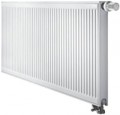Country of origin
The country of origin of the brand.
In most cases, either the homeland of the brand or the location of the manufacturer's headquarters is indicated as the country of origin. Production facilities may well be located in another country. However, it is worth noting here that most of the national stereotypes nowadays are unfounded — the quality of products depends not so much on geography but on the characteristics of the organization of the production process in a particular company. So from this point of view, when choosing, you should focus primarily on the reputation of a particular manufacturer. It makes sense to pay attention to the country of origin of the brand if you fundamentally want (or do not want) to support a company from a certain state.
Nowadays, the production of radiators is mainly carried out by companies from such countries:
England,
Belarus,
Belgium,
Germany,
Holland,
Spain,
Italy,
China,
Norway,
Poland,
Turkey,
Ukraine,
Finland,
Czech Republic.
Heat transfer medium volume
The volume of water or other heating medium required to fill the radiator.
This information is relevant mainly when building an autonomous heating system: it is useful when calculating the total volume of heating medium in the system and related parameters. If the radiator is purchased for use in centralized heating, you can not pay much attention to its internal volume.
Connection size
The diameter of the thread used to connect the radiator to the heating system. Modern radiators use standard sizes — for example,
3/4" or
1/2", less often
1" and
1 1/4". This indicator must match the dimensions of the pipes, couplings and other elements directly used for connection — otherwise, at best, you will need to install adapters, and at worst, the radiator will turn out to be unusable at all.
Usually, the larger the thread diameter, the more powerful the radiator (high power requires intensive circulation of the heating medium and an appropriate throughput at the inlet and outlet).

